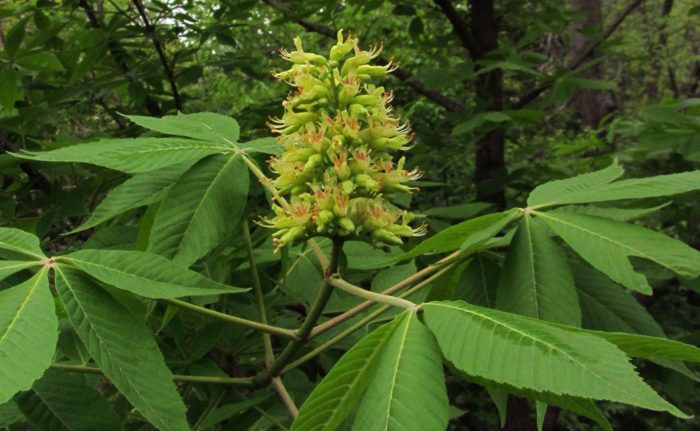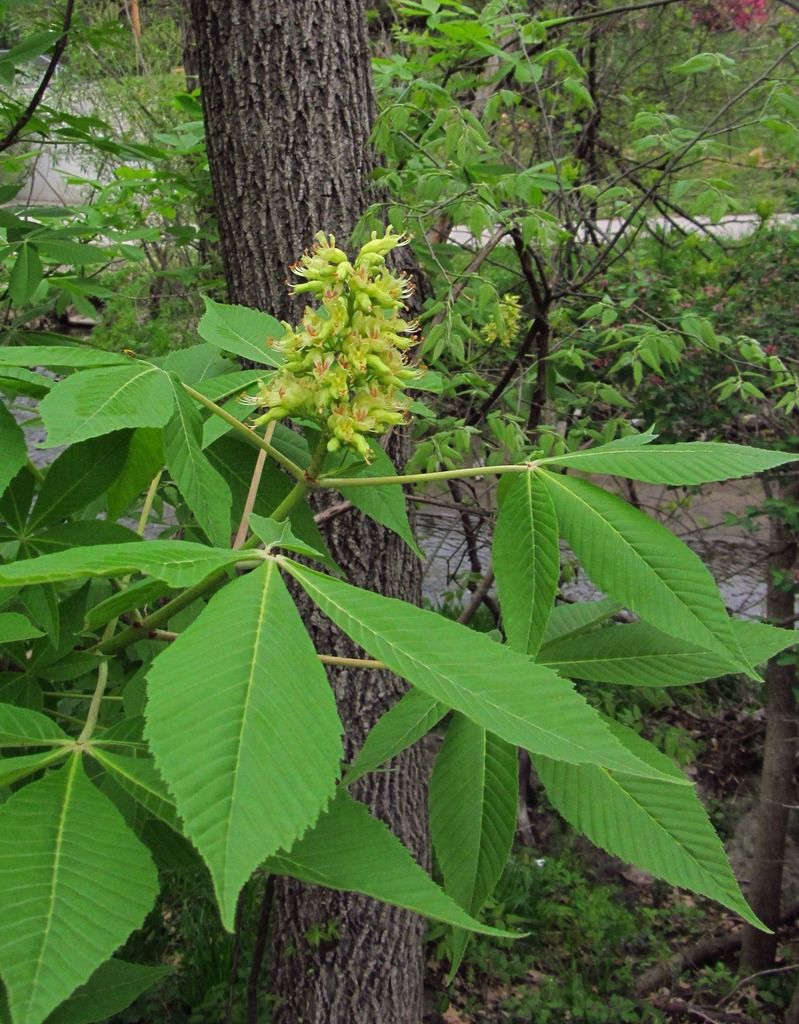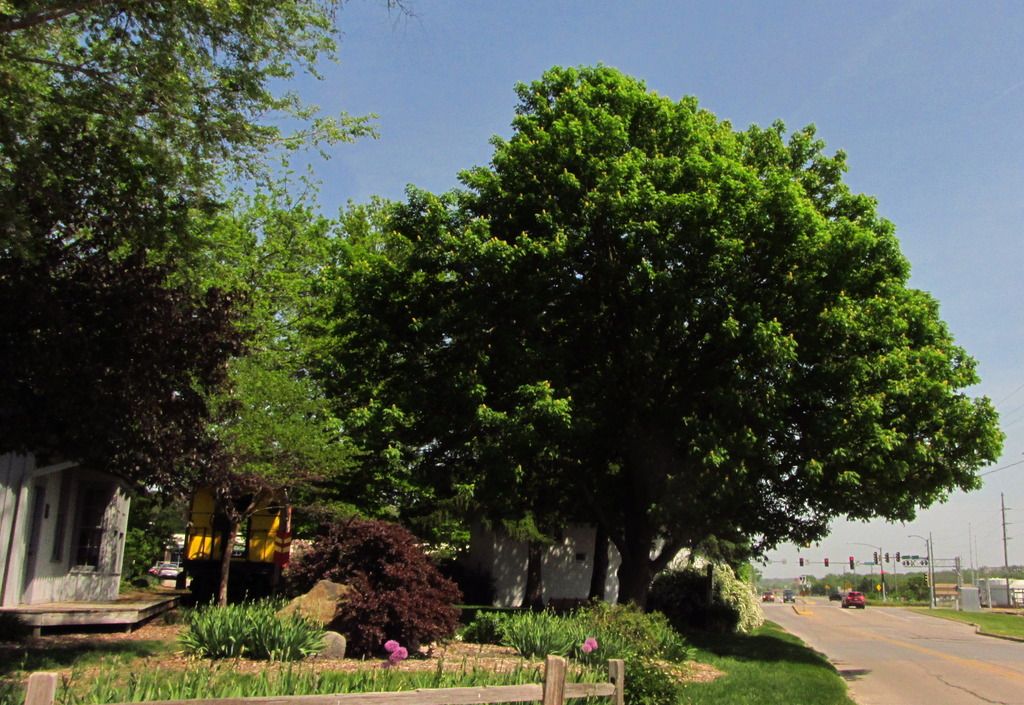I’ve rarely featured flowering trees for this series. I’m making an exception today for Ohio buckeye (Aesculus glabra), which is native to most of North America east of the Rocky Mountains. The tree is sometimes known as horse chestnut, buckeye, American buckeye, or stinking buckeye because its leaves give off “a strong fetid odor when crushed.”
The blossoms of Ohio buckeye are distinctive, and once you learn to recognize them, you’ll know where to come back in the fall to collect the round, smooth seeds.
Elizabeth Garst once told me that during one of her grandfather Roswell Garst‘s visits to the Soviet Union, his Russian host gave him a buckeye for good luck. He was surprised to learn some Americans follow the same tradition. According to the Lady Bird Johnson Wildflower Center’s website, “Pioneers carried a buckeye seed in their pockets to ward off rheumatism.” Wood from the tree was often used to carve children’s cradles or artificial limbs, “because it is light, easily worked, and resists splitting.”
I enclose below some pictures of buckeye trees now flowering in Clive and Windsor Heights.
Early spring wildflowers are mostly gone now, but if you venture into wooded areas during the coming week, you may find lots of Jack-in-the-pulpits, sweet William, sweet Cicely or aniseroot, false rue anemone, wild geranium, Missouri gooseberry, and Virginia waterleaf blooming. Buds are open on many May apples/umbrella plants and wild ginger too, but you have to bend down and look under the leaves to see them. Unfortunately, the invasive garlic mustard is also flowering and developing seed pods. If you see it when you are out and about, try to pull it up by the roots and throw it away in a garbage bag. (If you leave garlic mustard on the ground, the plants can take root start growing again.)
For botanically accurate descriptions of Ohio buckeye bark, leaves, and seeds, I recommend this fact sheet from the U.S. Department of Agriculture’s Natural Resources Conservation Service or the Illinois Wildflowers website.
These trees thrive in “moist to mesic deciduous woodlands, wooded valleys along rivers, and rocky wooded slopes in sheltered areas.”
This tree is growing near the bank of North Walnut Creek in Windsor Heights.
Pollinators of the flowers include ruby-throated hummingbirds as well as various kinds of bees and bumblebees.
Many people plant these trees in gardens. According to a post on the Ohio State University website, an Ohio buckeye “needs deep, well-drained, moist — but not wet — soil. The soil also can’t be too dry.” As for light, “sun to partial shade” is best.
This buckeye tree is growing along Swanson Boulevard in Clive, near 86th Street and the historic caboose and “old-time train depot.” I had trouble photographing the flowers, because they are all so high off the ground.
I used to enjoy taking my kids to collect buckeyes in the fall. But be aware that the seeds are choking hazards, so supervise carefully if you let young children play with them. During Chanukah, buckeyes have been a favorite for dreidel games in my family.
Never attempt to eat buckeyes if you crack them open. The USDA fact sheet warns,
All parts of the plant (leaves, bark, fruit) are highly toxic if ingested – because of the glycoside aesculin, the saponin aescin, and possibly alkaloids. Symptoms are muscle weakness and paralysis, dilated pupils, vomiting, diarrhea, depression, paralysis, and stupor. Many landowners have eradicated it to prevent livestock poisoning. Native Americans ground buckeye to use as a powder on ponds to stun fish.
All parts of buckeye trees are toxic to dogs as well.







4 Comments
Thanks for featuring buckeyes
I was born in Ohio, so I am a Buckeye. I grew up with the tradition of carrying a buckeye for luck and still do it. I see that in Iowa, buckeyes are native to the southeastern part of the state. I agree that collecting them is a lot of fun. I’ve noticed that squirrels are not very enthused about them, but they do finally disappear if put outside in my yard during the winter.
PrairieFan Wed 10 May 11:45 PM
Orioles and squirrels
When I see the buckeye ready to bloom, I know the arrival of Baltimore and orchard orioles will not be far away. The squirrels here readily bury the buckeye as they fall to the ground, but not sure they ever dig them up for a winter snack. Buckeye seedlings are everywhere but are easily pulled up. The buckeye is a easy tree to have in a yard as they don’t drop sticks that need to be picked up. Sometimes out in the timber edges, you can hear the ‘roar’ of bumblebees before you notice the buckeye that they have flocked to.
barry Thu 11 May 10:44 AM
I've never heard that before
about the link between these trees flowering and the arrival of orioles. Fascinating. I know very little about birds.
desmoinesdem Thu 11 May 10:45 PM
Buckeyes!
I know there are a lot of kids crafts for buckeyes, I am going to add a note to my post that there is a buckeye tree here, thanks for linking me 🙂
desmoinesoutdoorfun Sat 20 May 1:36 PM